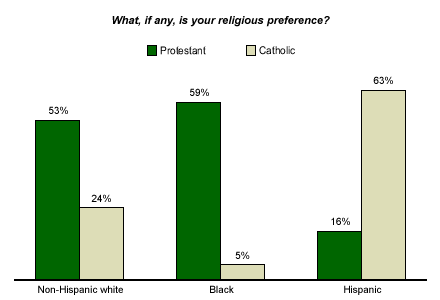Gallup's most recent Minority Rights and Relations poll* reveals that most whites and blacks attend congregations that reflect their race and ethnicity, while most Hispanics attend congregations that are racially and ethnically different. There are several possible explanations for the different makeup of these congregations, including the history of slavery and segregation and U.S. immigration and assimilation patterns. Another explanation stems from the differences between Protestants and Catholics.
The majority of Hispanics are Catholic, while most blacks and whites identify themselves as Protestant. According to the poll, 63% of Hispanics are Catholic and only 16% are Protestant -- nearly a 4-to-1 ratio. In comparison, only 5% of blacks are Catholic and 59% are Protestant -- a nearly 12-to-1 ratio. (A significant number of blacks, 16%, identify simply as "Christian" or some Christian denomination other than Protestant or Catholic.) Just 24% of non-Hispanic whites are Catholic and more than half (53%) are Protestant.

Transplanted and Cultivated Traditions
There are profound theological, cultural, and historical differences between the Catholic and Protestant traditions. In simple terms, the Catholic Church was essentially "transplanted" from European to American soil. Hispanics came to the New World from predominantly Catholic regions of Western Europe, and the immigrants brought the tradition with them.
Today, the Catholic Church remains under the centralized direction of a European pope. Catholic parishes are organized regionally, so a Catholic parish can have a wide range of racial diversity among its members, depending upon the racial and ethnic makeup of the population in the area it serves. While there may be unique ministries within a parish that meet the needs of Hispanics, the parish itself will likely be racially and ethnically diverse.
Denominational Protestantism, on the other hand, in many ways reflects the individualism and autonomy of American culture. Even though the major denominations in the United States (Methodist, Presbyterian, Lutheran, etc.) were born in Europe, they grew to adulthood on American soil. The countless Protestant denominations in the United States grew from self-formed congregations led by lay preachers, and most denominations have undergone organizations, splits, and reorganizations. Protestantism is less hierarchical, with more authority resting in congregations.
Whites and blacks could (and did), through the individualistic interpretation of the church and "salvation," form their own churches that suited their own purposes. Issues of slavery and segregation could be addressed, ignored, or justified depending on one's personal view of the Christian faith -- thus the establishment of white Protestant congregations and black Protestant congregations.
Bottom Line
Racial and ethnic minority congregations within Protestantism have served, and continue to serve, an important social purpose. Not only were black congregations the birthplace of the civil rights movement of the 1950s and 1960s, but they continue to be a platform for addressing issues that the black community faces today. They also are communities in which black heritage is preserved and celebrated. The same is true for the increasing number of Asian and Hispanic Protestant congregations.
In my view, the presence of racial and ethnic minority congregations is not a bad thing, either for those communities or for society as a whole. This is not a "separate-but-equal" argument, but an acknowledgement of the important role minority congregations have in not only celebrating culture, but also in "speaking truth to power": bringing issues of justice and equality before the white majority, which it might otherwise ignore or minimize.
Nevertheless, integration -- and the greater understanding of differences that it brings -- may in the long run be an even more positive trend for religious communities. Can congregations become more integrated without losing their vitality? Gallup's 2003 congregational engagement survey** offers positive news in this regard. The survey shows that 33% of members who attend congregations in which the race or ethnicity of most of the other members is different from themselves are engaged, compared with 27% of those attending congregations in which the other members are mostly the same race. Diversity, not homogeneity, appears to correlate more strongly with engagement, suggesting that a church that sets itself above racial divisions can be as strong or stronger than one that caters to any particular group.
*The results are based on telephone interviews with a national sample of 2,250 adults, aged 18 and older, conducted June 9-30, 2004. For results based on this sample, one can say with 95% confidence that the maximum margin of sampling error is ±5 percentage points. In addition to sampling error, question wording and practical difficulties in conducting surveys can introduce error or bias into the findings of public opinion polls.
For results based on the sample of 816 non-Hispanic whites, aged 18 and older, the maximum margin of sampling error is ±6 percentage points.
For results based on the sample of 801 blacks, the maximum margin of sampling error is ±8 percentage points.
For results based on the sample of 503 Hispanics, the maximum margin of sampling error is ±8 percentage points. (164 out of the 503 interviews with Hispanics were conducted in Spanish.)
**Results based on telephone interviews with 1,000 adult members of a church, synagogue, or other religious faith community, aged 18 and older, and 500 nonmembers, conducted in October and November 2003. For results based on this sample, one can say with 95% confidence that the margin of sampling error is ±2.6 percentage points.
